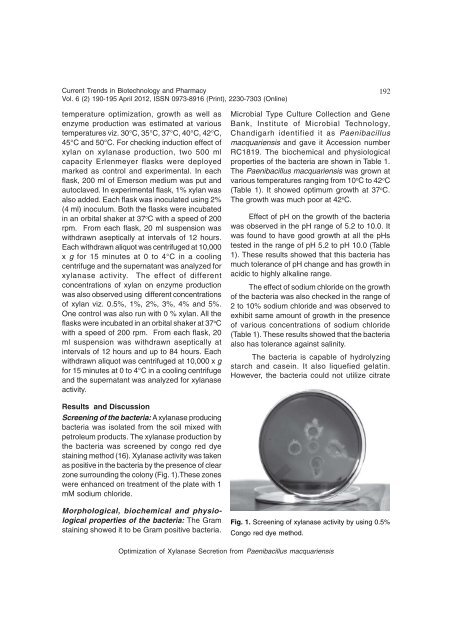d(GC) - Association of Biotechnology and Pharmacy
d(GC) - Association of Biotechnology and Pharmacy
d(GC) - Association of Biotechnology and Pharmacy
Create successful ePaper yourself
Turn your PDF publications into a flip-book with our unique Google optimized e-Paper software.
Current Trends in <strong>Biotechnology</strong> <strong>and</strong> <strong>Pharmacy</strong><br />
Vol. 6 (2) 190-195 April 2012, ISSN 0973-8916 (Print), 2230-7303 (Online)<br />
temperature optimization, growth as well as<br />
enzyme production was estimated at various<br />
temperatures viz. 30°C, 35°C, 37°C, 40°C, 42°C,<br />
45°C <strong>and</strong> 50°C. For checking induction effect <strong>of</strong><br />
xylan on xylanase production, two 500 ml<br />
capacity Erlenmeyer flasks were deployed<br />
marked as control <strong>and</strong> experimental. In each<br />
flask, 200 ml <strong>of</strong> Emerson medium was put <strong>and</strong><br />
autoclaved. In experimental flask, 1% xylan was<br />
also added. Each flask was inoculated using 2%<br />
(4 ml) inoculum. Both the flasks were incubated<br />
in an orbital shaker at 37 o C with a speed <strong>of</strong> 200<br />
rpm. From each flask, 20 ml suspension was<br />
withdrawn aseptically at intervals <strong>of</strong> 12 hours.<br />
Each withdrawn aliquot was centrifuged at 10,000<br />
x g for 15 minutes at 0 to 4°C in a cooling<br />
centrifuge <strong>and</strong> the supernatant was analyzed for<br />
xylanase activity. The effect <strong>of</strong> different<br />
concentrations <strong>of</strong> xylan on enzyme production<br />
was also observed using different concentrations<br />
<strong>of</strong> xylan viz. 0.5%, 1%, 2%, 3%, 4% <strong>and</strong> 5%.<br />
One control was also run with 0 % xylan. All the<br />
flasks were incubated in an orbital shaker at 37 o C<br />
with a speed <strong>of</strong> 200 rpm. From each flask, 20<br />
ml suspension was withdrawn aseptically at<br />
intervals <strong>of</strong> 12 hours <strong>and</strong> up to 84 hours. Each<br />
withdrawn aliquot was centrifuged at 10,000 x g<br />
for 15 minutes at 0 to 4°C in a cooling centrifuge<br />
<strong>and</strong> the supernatant was analyzed for xylanase<br />
activity.<br />
Results <strong>and</strong> Discussion<br />
Screening <strong>of</strong> the bacteria: A xylanase producing<br />
bacteria was isolated from the soil mixed with<br />
petroleum products. The xylanase production by<br />
the bacteria was screened by congo red dye<br />
staining method (16). Xylanase activity was taken<br />
as positive in the bacteria by the presence <strong>of</strong> clear<br />
zone surrounding the colony (Fig. 1).These zones<br />
were enhanced on treatment <strong>of</strong> the plate with 1<br />
mM sodium chloride.<br />
Morphological, biochemical <strong>and</strong> physiological<br />
properties <strong>of</strong> the bacteria: The Gram<br />
staining showed it to be Gram positive bacteria.<br />
192<br />
Microbial Type Culture Collection <strong>and</strong> Gene<br />
Bank, Institute <strong>of</strong> Microbial Technology,<br />
Ch<strong>and</strong>igarh identified it as Paenibacillus<br />
macquariensis <strong>and</strong> gave it Accession number<br />
RC1819. The biochemical <strong>and</strong> physiological<br />
properties <strong>of</strong> the bacteria are shown in Table 1.<br />
The Paenibacillus macquariensis was grown at<br />
various temperatures ranging from 10 o C to 42 o C<br />
(Table 1). It showed optimum growth at 37 o C.<br />
The growth was much poor at 42 o C.<br />
Effect <strong>of</strong> pH on the growth <strong>of</strong> the bacteria<br />
was observed in the pH range <strong>of</strong> 5.2 to 10.0. It<br />
was found to have good growth at all the pHs<br />
tested in the range <strong>of</strong> pH 5.2 to pH 10.0 (Table<br />
1). These results showed that this bacteria has<br />
much tolerance <strong>of</strong> pH change <strong>and</strong> has growth in<br />
acidic to highly alkaline range.<br />
The effect <strong>of</strong> sodium chloride on the growth<br />
<strong>of</strong> the bacteria was also checked in the range <strong>of</strong><br />
2 to 10% sodium chloride <strong>and</strong> was observed to<br />
exhibit same amount <strong>of</strong> growth in the presence<br />
<strong>of</strong> various concentrations <strong>of</strong> sodium chloride<br />
(Table 1). These results showed that the bacteria<br />
also has tolerance against salinity.<br />
The bacteria is capable <strong>of</strong> hydrolyzing<br />
starch <strong>and</strong> casein. It also liquefied gelatin.<br />
However, the bacteria could not utilize citrate<br />
Fig. 1. Screening <strong>of</strong> xylanase activity by using 0.5%<br />
Congo red dye method.<br />
Optimization <strong>of</strong> Xylanase Secretion from Paenibacillus macquariensis













